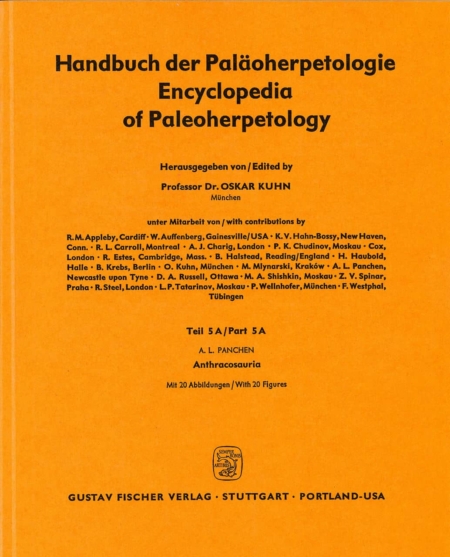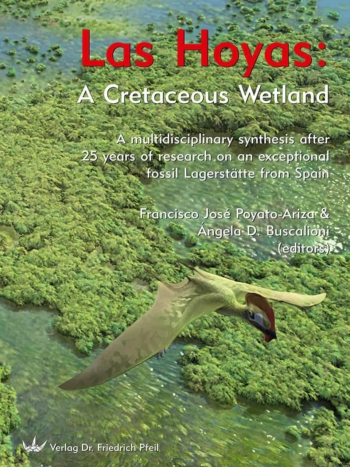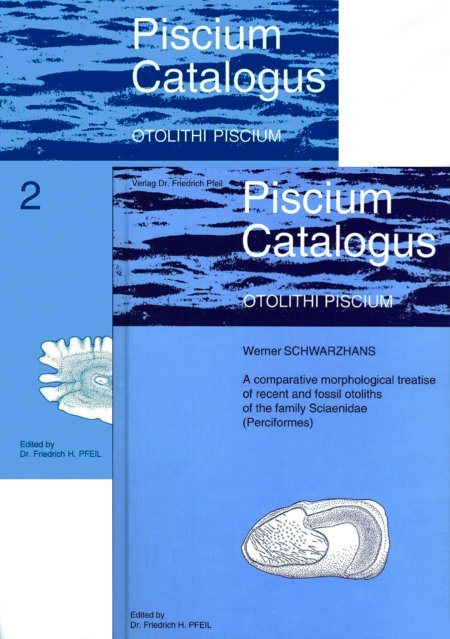Introduction 1
Acknowledgements 3
Historical Review 4
General Osteology – Skull 8
Dermal Skull Roof 8
Dermal Roofing Bones 10
Origin of the Anthracosaur Dermal Roofing Pattern 12
Occiput 14
Parasphenoid and Braincase 14
Palate 17
Lower Jaw18
Dentition 21
Branchial Arch Skeleton 23
Functional Morphology 24
Axial Skeleton 26
Vertebrae 26
Ribs 28
Functional Morphology 30
Appendicular Skeleton and Armour 32
Pectoral Girdle 32
Fore Limb 34
Pelvic Girdle 35
Hind Limb 37
Functional Morphology 40
Scales 42
Systematic Review 43
Suborder Anthracosauria SÄVE-SÖDERBERGH 1934 43
Family Anthracosauridae COPE 1875 43
Anthracosaurus HUXLEY 1863 43
Eobaphetes MOODIE 1916 45
Family Eogyrinidae WATSON 1929 45
Pteroplax HANCOCK & ATTHBY 1868 48
Pholiderpeton HUXLEY 1896 48
Eogyrinus WATSON 1926 50
Palaeoherpeton nov. 50
Neopteroplax ROMER 1963 52
Calligenethlon STEEN 1934 52
Memonomenos STEEN 1938 53
Diplovertebron FRITSCH 1879 53
Nummulosaurus FRITSCH 1900 55
Leptophractus COPE 1873 56
Famiiy Archeriidae KUHN 1965 56
Archeria CASE 1915 58
Cricotus COPE 1875 58
Spondylerpeton MOODIE 1912 60
Incertae Sedis and Not Anthracosaur 61
Pholidogaster pisciformis HUXLEY 1862 61
Crassigyrinus scoticus WATSON 1929 62
Macromerium scoticum LYDEKKER 1890 63
Papposaurus traquairi WATSON 1914 63
Ichthyerpeton bradleyae HUXLEY 1867 63
Discospondylus et al. HUXLEY 1867 64
Eosaurus acadianus MARSH 1862 64
Baphetes minor DAWSON 1870 64
"The Pictou Girdle" 65
Ichthycanthus platypus COPE 1877 65
Cricotillus brachydens CASE 1902 65
Mode of Life 66
Geological and Geographical Distribution 68
Origin and relationships 73
Literature Cited 78
Index of Genera and Higher Taxa 83
HPH 5A • Batrachosauria (Anthracosauria)
1970. [English] – VII, 83 pp., 20 figures.
25.5 x 20.5 cm, paperback.
Series: Handbook of Paleoherpetology
44,99 € Original price was: 44,99 €.35,00 €Current price is: 35,00 €.
plus shipping costs
The anthracosaurs, using the term in its original sense, are a group of usually large aquatic Amphibia from the Carboniferous and lower Permian. They have the full complement of dermal bones of the skull roof found in primitive tetrapods and to a variable extent the roofing bones of the skull are ornamented in characteristic 'pit and ridge' fashion. The vertebral centra consist of two regions, a pleurocentxum and an intercentrum, and the teeth in cross-section demonstrate a characteristic labyrinthine infolding of the dentine.
All these features characterise them as members of the amphibian subclass Labyrinthodontia, but they differ from the vast majority of (temnospondyl) labyrinthodonts in several important features: the tabular bones on either side of the back of the skull table are elongate anteromedially to contact the parietals and posteriorly to produce a characteristic horn; a remnant of the skull kinetism found in rhipidistian fish is retained in the movable contact between the sides of the skull table and the squamosal bones of the cheek region, and the vomers are narrow and toothless.
The body was long and anguilliform with small limbs : where known the manus and pes bear five principal digits. In the vertebrae the pelurocentrum is the larger central element and is firmly attached by broad facets to the neural arch. The intercentrum is, however, also a complete but narrower disc and both are centrally notochordal. The vertebrae, known after COPE as embolomerous, are diagnostic.
Some of the characters noted above are shared with a group of labyrinthodonts known, after Seymouria from the lower Permian of Texas, as the Seymouriamorpha (s.l.). These, however, were short-bodied forms lacking the tabular horn and usually the kinetic skull table and with a strongly reduced crescentic intercentrum. Nevertheless the Anthracosauria and Seymouriamorpha are normally grouped together as a major taxon, distinct from all other labyrinthodonts, termed by ROMER (1947, 1966) the Anthrocosauria (s.l.).
Some of the features shared by the anthracosaurs and the seymouriamorphs are also characteristic of early reptiles and for this reason the anthracosaurs have long attracted attention as potential reptile ancestors, while the known seymouriamorphs have been regarded as relict intermediate forms. The importance of the anthracosaurs in this respect was strongly emphasised by the work of D. M. S. WATSON who also sought to show that their primitive anatomy and early geological occurrence made them ideal intermediates between rhipidistian fish and later tetrapods.
The anthracosaurs are most characteristically found as a rare element of the fauna of the British Coal Measures and the corresponding period of the North American Pennsylvanian. British finds are almost always found closely associated with coal seams, usually in a canneloid shale or ironstone roofing the seam and were undoubtably members of a coal swamp fauna. The name anthracosaur, after the Scottish Anthracosaurus russelli HUXLEY, refers to this. The body form and small limbs also suggest that they were persistently aquatic.
It is probably advisable to say something at this point about the usage of the term Anthracosauria although this is developed historically in the next section. The original usage, formalised by SÄVE-SÖDERBERGH (1934) and employed in this monograph, includes only the embolomerous long-bodied Amphibia characterised above. It is probable that among the labyrinthodonts embolomerous vertebrae are confined to this group as argued by ROMER (1947) who terms them the Embolomeri. WATSON, however, on strong negative evidence thought otherwise and his grade Embolomeri included temnospondylous labyrinthodonts. His usage of Anthracosauroideae (1929) was, however, quite unambiguous. ROMER's usage includes the Seymouriamorpha, as noted above, and also some forms which he claims have pre-embolomerous vertebrae, notably Pholidogaster.
...
You must be logged in to post a review.
"*" indicates required fields
Related products
We’re here for you
Verlag Dr. Friedrich Pfeil
Hauptstraße 12B
5232 Bergkirchen OT Günding – Germany
Tel.: +49 8131 61 46 590
Fax: +49 8131 61 46 591
E-Mail: info@pfeil-verlag.de
Contact
Tel.: +49 89 742827-0
Fax: +49 89 7242772
E-Mail: info@pfeil-verlag.de






Reviews
There are no reviews yet.